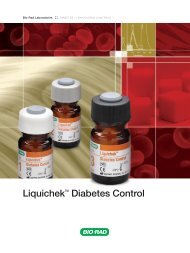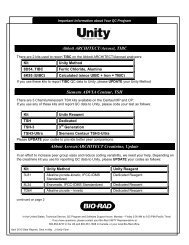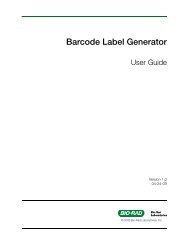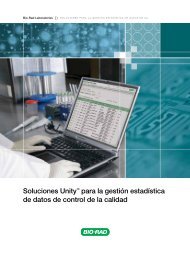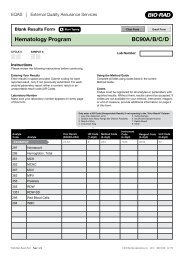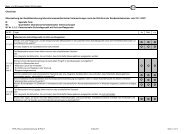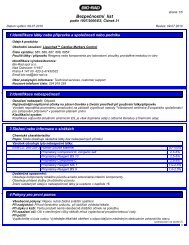EQAS Program User Guide - QCNet
EQAS Program User Guide - QCNet
EQAS Program User Guide - QCNet
Create successful ePaper yourself
Turn your PDF publications into a flip-book with our unique Google optimized e-Paper software.
Chapter 9: GlossaryNIs used to indicate the number of results received or the number of values in a dataset.National Performance Score HistogramA visual representation of the performance scores of all laboratories within the same country in a givenprogram cycle. The X-axis (horizontal) shows a quintile distribution of performance scores for participatinglaboratories. The best scores are located to the left side of the graph. The Y-axis (vertical) reflects the numberof participants. The number of participants in each quintile is displayed above the associated histogram bar.The performance score for each laboratory is calculated by creating an overall peer mean, absolute Z-scoreacross all samples and analytes. Penalties are applied for late and amended results submitted by thelaboratory, then normalized based on the number or results the laboratory reported in the cycle. Yourlaboratory’s performance relative to others in your country is indicated as placement in one of the quintiles.PeerPeer describes the comparator level where participants are reporting the same analyte with the samemethodology on the same instrument or instrument grouping with similar reagents. This is the most specificlevel of comparison for your results. If there are less then 9 results present in the dataset, your comparatorlevel will move to the next level (Method or Mode).Percentage Deviation (%)The bias of your laboratory’s result expressed as a percentage of the reported comparator mean.Your result – Comparator meanComparator meanx 100Proficiency Testing/External Quality AssessmentA program in which multiple blind specimens are periodically evaluated by a group of laboratories forinterlaboratory analysis and/or identification. Each laboratory’s results are compared with those of the otherlaboratories in the group and/or with an assigned value, and reported to the participating laboratory andothers.QuintileA data set representing 20% of the total population. The first quintile represents the first one-fifth of thepopulation (1%–20%); the second quintile represents the second fifth (21%–40%) etc.Random ErrorAn error in measurement that occurs in an unpredictable way. Random errors do not affect measurements thesame way. They may produce either a positive or negative deviation, the direction and magnitude of whichcannot be predicted. This is in contrast to systematic error, which affects all measurements in the same way.It is not possible to correct for random error.ReagentA substance that produces a reaction, especially one that can be used to detect, measure or produce anothersubstance that results in an “answer” for a particular test.<strong>EQAS</strong> <strong>Program</strong> <strong>User</strong> <strong>Guide</strong> 101





